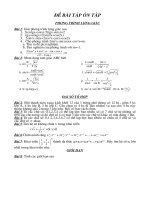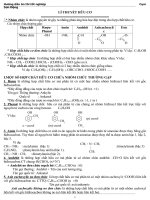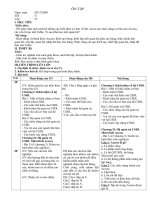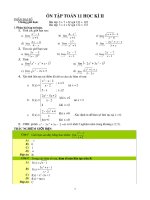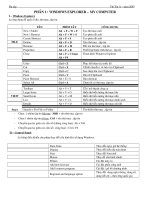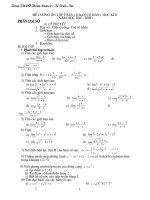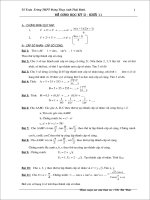4 tiết ôn tập HK1_Anh 11
Bạn đang xem bản rút gọn của tài liệu. Xem và tải ngay bản đầy đủ của tài liệu tại đây (385.97 KB, 9 trang )
Review lesson 1
Date of preparing:
Date of teaching:
1. Objectives:
- Teach and review tenses in English: Present simple, present continuous and present
perfect.
- Distinguish the use and functions of these tenses.
2. Teaching aids:
- Handouts, posters
3. Procedure:
Tim
e
Steps
Work
arrangement
10’
15’
Presentation
Study this example situations:
Ann is in her car. She is on her way to work. She is
driving to work.
This means: She is driving now, at the time of speaking.
The action is not finished.
am/ is/are - ing is the Present continuous:
* I am doing something = I’m in the middle of doing
something; I’ve started doing it and I haven’t finished yet.
- T. shows the poster with some examples to study the uses
and functions of Present continuous.
* We use the present continuous when we talk about things
happening in a period around now.
Exercises
(handouts).
? Put the verb into correct form.
Eg. We can’t go out now. It (not rain) ......now any more
→ isn’t raining
Presentation
Study this example situation:
Alex is a bus driver, but now he is in bed asleep. So: He is
not driving a bus (He is asleep)
but He drives a bus (He is bus driver)
drive(s)/work(s)/do(es)....is the Present continuous.
I/we/you/they drive/work...
She/he/it drives/works...
*We use the present simple to talk about things in
general. We are not thinking only about now. We use it to
say that something happens all the time or repeatedly, or
that something is true in general.
Rememeber that we say: he/she/it -s
Exercise
Pair work &
whole class
Group work
Whole class
& Pair work
Individual work
12’
10’
3’
(Handouts)
Eg. Rice (not grow)... in Britain.
→ doesn’t grow
* Comparison:
- The water is boiling. Can you turn it off ?
- Water boils at 100
o
C
* we don’t use the following verbs in continuous tense.
like know need
taste smell belong
understand ... ..
Presentation
Study this example situation.
- Tom is looking for his key. He can’t find it. He has lost
his keys = he lost it and he still hasn’t got it.
Have /has lost is the present perfect simple.
* When we use the present perfect there is always a
connection with now. The action in the past has a result
now.
We use the present perfect with just, already and yet
Exercise
(Handouts)
Eg. They (already/ write )to her.
→ have already writer
In the following examples too the speakers, are talking
about a period that continues untill now
(recently/so far/ since/for ...
Eg. Have you learned from Halee
Note that: we say “it is the first time smt have happned.
(present perfect), using handouts.
Homework
- T. summarises the main teching boy
- sts complete some exercise.
& whole class
Group work &
whole class
Group work &
whole class
Whole class
Individual work
Whole class
* Comment
Review lesson 2
Date of preparing:
Date of teaching:
1. Objectives:
By the end of the lesson sts will able to understand and practise:
- sequence of tenses
- improve the use of the conjunctions: when, as, no sooner, by the time...
2. Teaching aids:
Handouts, textbooks.
3. Anticipated problems:
Sts may have difficulties reviewing tenses of English so T. should repeat the use and the
form.
4. Procedure:
Tim
e
Steps
Work
arrangement
3’
Warm - up
- T. divides the class into the groups of 3 to rewrite all the
conjunction they have learned.
Eg: because, if .....
- T. checks and sorts out these conjunctions sts write.
- T. explains and leads into the lesson.
Whole class &
Group work
10’
New lesson
1. Presentation.
In general, A sentence has more than two clauses, verbs
have sequence of tenses.
a) Presentation: The sequence of verbs in main clauses and
subordinate clause:
Main clause Subordinate clause
1. Simple Present
- Simple present
- Present perfect
- Present continuous
- Simple future/near future
- Simple past
2. Simple Past
- Simple past
- Past perfect
- Past continuous
- would/were/was going to
- Simple present
3. Present Perfect
- Simple present
4. Past Perfect
- Simple past
b) Practice.
- T. elicits and explains by using the handouts
Eg:
* People have said that London has fog
* She says she has finished her homework already.
Whole class &
group work,
individual work
* She said she would visit me again.
* They had done what was necessary.
10’
a) Presentation: The sequence of verbs in main clauses and
adverbial clause of time:
Main clause adverbial clause of time
1. Present Tenses Present Tenses
2. Past Tenses Past Tenses
3. Future Tense Present Tenses
* Adverbial clause of time is often begun by:
- when
- whenever
- as
- while
.....
- until
- just as
- since
- no sooner ...than
....
* Present Tenses: For all present tenses are up to the
context, content.
* Past Tenses: For all past tenses are up to the context.
* Future Tenses: For all past tenses are up to the context of
the sentences.
b) Practice.
Eg:
- James never goes home before he has finished his work
- I often read a novel while I am waiting for the bus.
- It was raining hard when I got there.
- He had already left when I arrived home.
- By the time I come, she will have cleaned the room.
Whole class &
group work,
individual work
20’
2. Practice.
- T. gives the handouts for sts to complete individually and
then compare with their partner.
- T. calls on some sts to write down their answer on the
board and asks other sts for their comments.
- T. checks with the whole class and gives the corrective
feedback, and comments.
Individual work
Whole class &
group work
2’
Homework
- T. summarizes the main points.
- T. gives the handouts for sts to complete.
Whole class
* Comments:
Review lesson 3
Date of preparing:.
Date of teaching:
1. Objectives:
By the end of the lesson, sts will be able to review grammar: Verbs followed by
-ing or infinitive
2. Teaching aids:
Handouts and textbooks
3. Procedure:
Time Contents
Work
arrangement
3’
Warm - up
- T. divides the class into the groups of 2 to write down
all the verbs followed by -ing and infinitve.
Answers:
G1: want/refuse/decide.....
G2: enjoy/mind/avoid....
- T. checks and guidelines sts to make sentences using the
verbs above:
Eg: They decided not to go by air.
Group work &
Whole class
15’
New lesson
a) Explanation:
This lesson focuses on problems areas:
* Verbs followed by either -ing or infinitive with to.
1. can t bear, hate, like, love and prefer.’
Like to usually refers to habitual preferences.
Eg: We like to go out to lunch on Sunday
Not like to means think it wrong to.
Eg: I don t like to call him.’
2. attempt, begin, continue, intend, plan, propose, start..
There is no difference in meaning whether we use -ing or
infinitive with to
3. forget, remember
With to both verbs refer to an obligation.
Eg: I had to phone him but I forgot to do it.
I don t remember learning to walk.’
4. try
With to this refers to something attempted, which might fail
or succeed.
With -ing this refers to making an experiment, or to a
Whole class &
group work,
individual work
